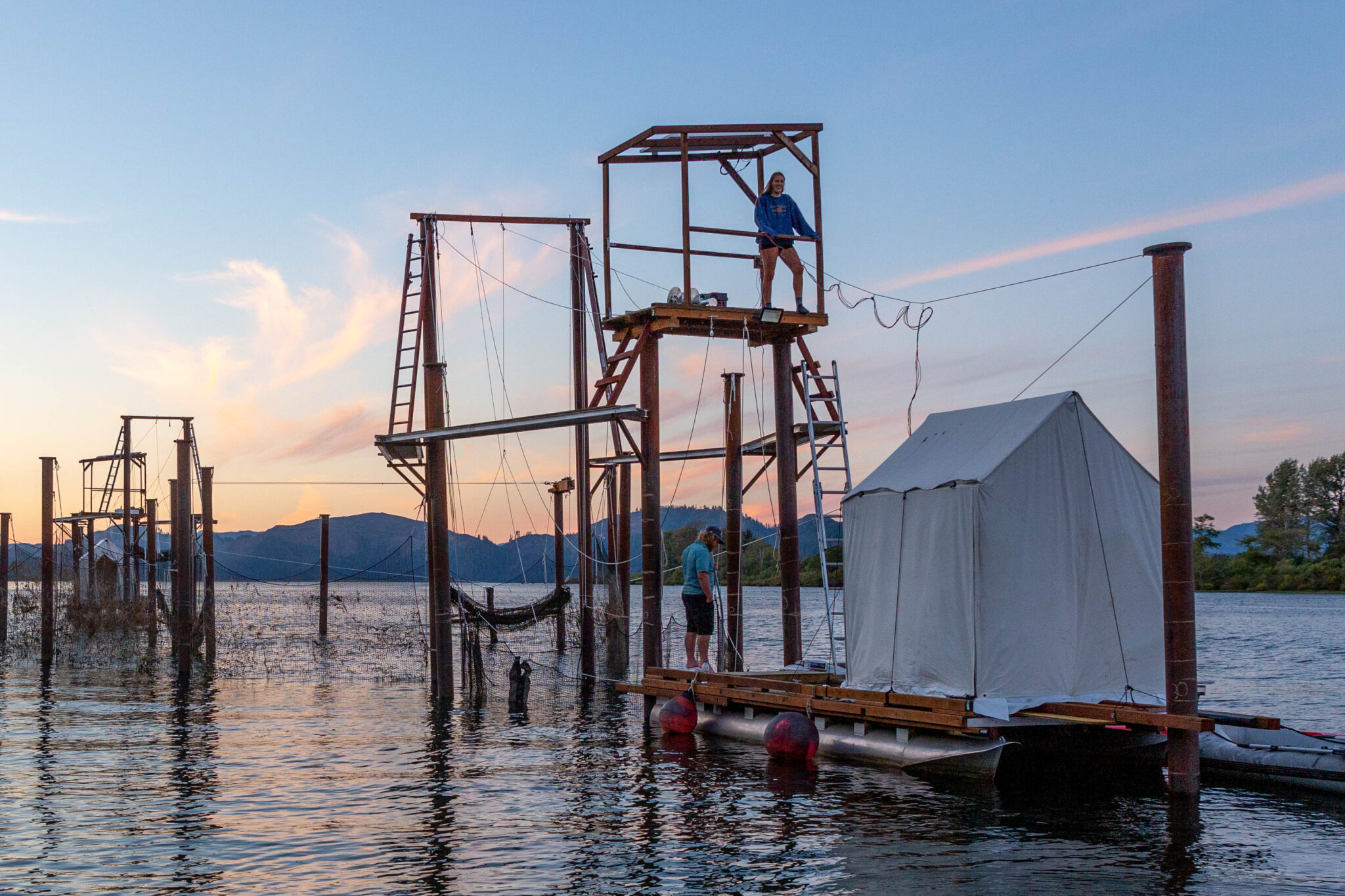
Nearly a century ago, fish traps were banned in Washington State due to poor management that led to overharvest and the decline of wild salmon populations. Now, in a historic moment, fish traps will return to the Columbia River for the first time since 1934—this time as a tool to advance the protection and recovery of the basin’s threatened wild salmon and steelhead.
Once seen as the problem in the past, the fish trap has become a solution for the future. Serving as a sustainable alternative to conventional gillnets that are known to cause bycatch mortality, contemporary fish traps provide a new means for fishers to safely sort their catch, selectively harvest hatchery fish, and release all wild salmon and steelhead bycatch for population recovery.

Figure 1. Fish trap construction on the lower Columbia River in Washington State.
After a decade of research demonstrating the unique ability of modified fish traps to help fishers protect wild salmon and steelhead encountered in fisheries, the states of Washington and Oregon have authorized the first season of commercial fishing with fish traps to determine the tool’s viability for broader commercial application in the lower Columbia River. While previous research by Wild Fish Conservancy (WFC) clearly demonstrated the conservation benefits of fish traps, their economic viability for fishers—absent government grants or subsidies—has yet to be tested as a legalized commercial fishery.
As soon as August 18, 2025, local fishers from Washington and Oregon will operate three commercial fish traps for the first time in nearly a century in the lower Columbia River. These fishers aim to support the recovery of wild salmon and steelhead by safely releasing all fish of wild origin and selectively harvesting only the hatchery fish that may otherwise stray to wild salmon spawning grounds and harm the genetics of wild salmon populations.

Figure 2. Wild Fish Conservancy staff member Joe Verelli passive fishing on a Columbia River fish trap.
This unique fishery will be monitored 100% by Washington Department of Fish and Wildlife, with additional monitoring and technical support provided by WFC staff. Continued monitoring efforts will work to further advance and deepen our scientific understanding of the technology and its benefits to the environment. The findings will also be used to help policymakers determine the economic viability of fish traps and their potential role in supporting local fishing communities and their economies while advancing wild salmon and steelhead recovery.
Additional research and monitoring of the Columbia River fish traps remains in stark contrast to that of the ongoing conventional gillnet fishery, which is unobserved on an annual basis and unstudied for its impacts to wild steelhead. Unlike the conventional commercial fisheries that have operated on the Columbia River over the last century, the emerging fish trap fishery is the only salmon fishery in the basin to be studied in depth and likely to achieve sustainability certification—guiding consumers toward responsible choices and providing price benefits to fishers contributing to wild salmon recovery.

Figure 3. Commercial fisher Billie Delaney hanging nets at the Clifton Channel fish trap in Oregon.
As local fishers of the Columbia work hard to revitalize fish traps as a sustainable path forward for wild fish and fishing communities, they are also helping to shape a model for broader application in fisheries spanning the West Coast. First Nations across British Columbia have already embraced the research and initiated efforts to implement fish traps in rivers such as the Skeena and Campbell. These efforts will help alleviate issues related to bycatch mortality, improve efforts to harvest robust stocks selectively, and provide a low-impact means to monitor fish runs in-season for adaptive fisheries management.
With history in the making, WFC will be providing regular updates as this historic fishery gets underway in the lower Columbia River. As we work hand-in-hand with local fishers to implement the basin’s first sustainable salmon fishery, the Fish Trap Journal will be your news source for the daily trials and tribulations in advancing much needed change in the Pacific Northwest’s most iconic salmon fishery.
We are so grateful to all our members who have supported the fish trap project over the last decade. This historic moment and solution would not be possible without you.
Explore our Video Library to see a visual journey of WFC’s fish trap work over the past decade.

Figure 4. Clifton Channel fish on the Lower Columbia River in Oregon.